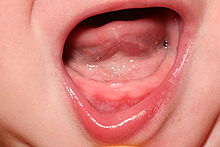Teething
Teething is the process by which an infant's teeth sequentially appear by breaking through the gums. Teething may start as early as three months or as late, in some cases, as twelve months. The typical time frame for new teeth to appear is somewhere between six and nine months. It can take up to several years for all 20 deciduous (aka "baby" or "milk") teeth to emerge. The process of teething is sometimes referred to as "cutting teeth".
Sequence of appearance


The infant teeth tend to emerge in pairs - first one lower incisor emerges then the other lower incisor emerges before the next set begin to emerge. The general pattern of emergence is:
- Lower central incisors (2)
- Upper central incisors (2)
- Upper lateral incisors (2),
- Lower lateral incisors (2)
- First molars (4)
- Canines (4)
- Second molars (4)
Milk teeth tend to emerge sooner in females than in males. The exact pattern and initial starting times of teething appear to be hereditary. When and how teeth appear in an infant has no bearing on the health of the child.
Signs of teething
Signs of teething may include:
- Poor mood[citation needed]
- Loss of appetite[citation needed]
- Chewing of objects[citation needed]
- Bruises/swelling in gums[citation needed]
- Excess salivation[citation needed]
- Runny nose[citation needed]
Teething has not been shown to cause fever or diarrhea.[1] A slight rise of temperature may occur when the teeth come through the gum[citation needed], but this does not make a baby ill.
Treatment
Infants chew on objects to aid in the teething process. This can be dangerous if the baby is allowed to chew on objects which are small enough to be swallowed or which could break while being chewed and cause choking. Teething rings and other toys, called teethers, are often designed with textures that will appeal to an infant during teething.
In cases where the infant is in obvious pain, some doctors recommend the use of anti-inflammatories or child-safe pain-relief treatments containing benzocaine. Some infants gain relief from chewing on cold objects.
Dentists recommend brushing infants' teeth as soon as they appear. It is not advisable to wait for the teething process to be complete. Dentists may recommend against the use of fluoride toothpaste during teething.
Another way to soothe a babies gums while they are teething is using teethers.[citation needed]
See also
References
- ^ Tintinalli, Judith (2004). Emergency Medicine: A Comprehensive Study Guide, Sixth edition. McGraw-Hill Professional. p. 1483. ISBN 0071388753.
{{cite book}}: Cite has empty unknown parameter:|coauthors=(help)
